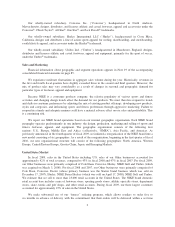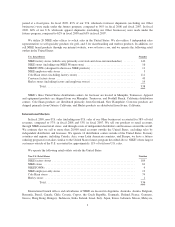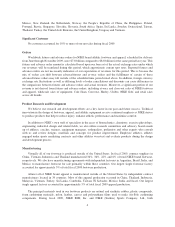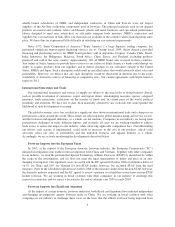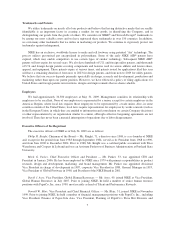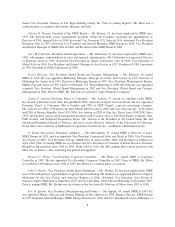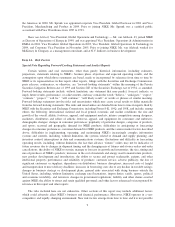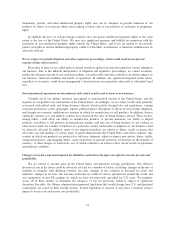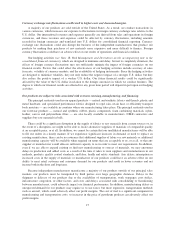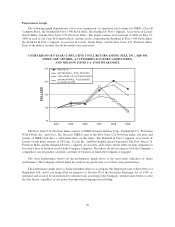Nike 2009 Annual Report Download - page 14
Download and view the complete annual report
Please find page 14 of the 2009 Nike annual report below. You can navigate through the pages in the report by either clicking on the pages listed below, or by using the keyword search tool below to find specific information within the annual report.• Continued volatility in the markets and prices for commodities and raw materials we use in our
products and in our supply chain (such as petroleum) could have a material adverse effect on our costs,
gross margins, and profitability.
• If retailers of our products experience declining revenues, or retailers experience difficulty obtaining
financing in the capital and credit markets to purchase our products, this could result in reduced orders
for our products, order cancellations, inability of retailers to timely meet their payment obligations to
us, extended payment terms, higher accounts receivable, reduced cash flows, greater expense
associated with collection efforts, and increased bad debt expense.
• If retailers of our products experience severe financial difficulty, some may become insolvent and
cease business operations, which could reduce the availability of our products to consumers.
• If contract manufacturers of our products or other participants in our supply chain experience difficulty
obtaining financing in the capital and credit markets to purchase raw materials or to finance general
working capital needs, it may result in delays or non-delivery of shipments of our products.
Our business is affected by seasonality, which could result in fluctuations in our operating results and stock
price.
We experience moderate fluctuations in aggregate sales volume during the year. Historically, revenues in
the first and fourth fiscal quarters have slightly exceeded those in the second and third fiscal quarters. However,
the mix of product sales may vary considerably from time to time as a result of changes in seasonal and
geographic demand for particular types of footwear, apparel and equipment. In addition, our customers may
cancel orders, change delivery schedules or change the mix of products ordered with minimal notice. As a result,
we may not be able to accurately predict our quarterly sales. Accordingly, our results of operations are likely to
fluctuate significantly from period to period. This seasonality, along with other factors that are beyond our
control, including general economic conditions, changes in consumer preferences, weather conditions,
availability of import quotas and currency exchange rate fluctuations, could adversely affect our business and
cause our results of operations to fluctuate. Our operating margins are also sensitive to a number of factors that
are beyond our control, including shifts in product sales mix, geographic sales trends, and currency exchange rate
fluctuations, all of which we expect to continue. Results of operations in any period should not be considered
indicative of the results to be expected for any future period.
“Futures” orders may not be an accurate indication of our future revenues.
We make substantial use of our “futures” ordering program, which allows retailers to order five to six
months in advance of delivery with the commitment that their orders will be delivered within a set period at a
fixed price. Our futures ordering program allows us to minimize the amount of products we hold in inventory,
purchasing costs, the time necessary to fill customer orders, and the risk of non-delivery. We report changes in
futures orders in our periodic financial reports. Although we believe futures orders are an important indicator of
our future revenues, reported futures orders are not necessarily indicative of our expectation of changes in
revenues for any future period. This is because the mix of orders can shift between advance/futures and at-once
orders. In addition, foreign currency exchange rate fluctuations, order cancellations, returns, and discounts can
cause differences in the comparisons between futures orders and actual revenues. Moreover, a significant portion
of our revenue is not derived from futures orders, including at-once close-out sales of NIKE footwear and
apparel, wholesale sales of equipment, Cole Haan, Converse, Hurley, NIKE Golf and Umbro, and retail sales
across all brands.
Our “futures” ordering program does not prevent excess inventories or inventory shortages, which could
result in decreased operating margins and harm to our business.
We purchase products from manufacturers outside of our futures ordering program and in advance of
customer orders, which we hold in inventory and resell to customers. There is a risk we may be unable to sell
12


